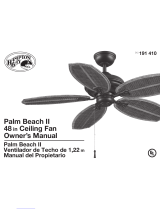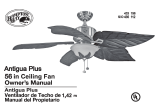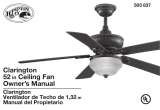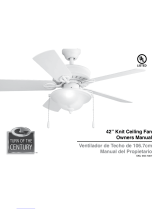Page is loading ...

454 849
s/o 455 805
s/o
Tropics
54
Tropics
7

54” Tropics
Ceiling Fan by Hampton Bay
(2) 60 Watt Intermediate
Base Bulbs Included
Tuscan Amber Glass
3-Speed Reverse Function for
Year-Round Comfort and Savings
Full Function Remote
Control Included
QUESTIONS, PROBLEMS, MISSING PARTS:
Before returning to your local Home Depot, please call our
Customer Service Team at 1-877-527-0313 or visit www.homedepot.com.
Please reference your SKU (454 849 weathered cane)
or UPC (082392 390877 weathered cane).
Thank you for purchasing this Hampton Bay ceiling
fan. This product has been manufactured with the
highest standards of safety and quality. The nish
of this fan is weather resistant, but over time will
naturally weather and fade.
Safety Rules ...................................... 1
Unpacking Your Fan ........................ 2
Installing Your Fan .......................... 3
Operating Your Fan ......................... 9
Operating Your Remote Control .... 10
Care of Your Fan .............................. 11
Troubleshooting ................................ 11
Specications .................................... 12
Warranty Information ..................... 13
Table of Contents
UL Model No. 54-TS

Safety Rules ...................................... 1
Unpacking Your Fan ........................ 2
Installing Your Fan .......................... 3
Operating Your Fan ......................... 9
Operating Your Remote Control .... 10
Care of Your Fan .............................. 11
Troubleshooting ................................ 11
Specications .................................... 12
Warranty Information ..................... 13
1. To reduce the risk of electric shock, insure electricity
has been turned off at the circuit breaker or fuse box
before beginning.
2. All wiring must be in accordance with the National
Electrical Code ANSI/NFPA 70-1999 and local electrical
codes. Electrical installation should be performed by a
qualied licensed electrician.
3. WARNING: To reduce the risk of re or electric shock,
this fan should only be used with fan speed control part no.
UC7067RC, manufactured by Rhine Electronic Co., Ltd.
4. CAUTION: To reduce the risk of personal injury, use only
the screws provided with the outlet box.
5. The outlet box and support structure must be securely
mounted and capable of reliably supporting a minimum of
35 pounds. Use only UL Listed outlet boxes marked “FOR
FAN SUPPORT.”
6. The fan must be mounted with a minimum of 7 feet
clearance from the trailing edge of the blades to the oor.
7. Avoid placing objects in path of the blades.
8. To avoid personal injury or damage to the fan and
other items, be cautious when working around or
cleaning the fan.
9. Do not use water or detergents when cleaning the fan or fan
blades. A dry dust cloth or lightly dampened cloth will be
suitable for most cleaning.
10. After making electrical connections, spliced conductors
should be turned upward and pushed carefully up into
outlet box. The wires should be spread apart with the
grounded conductor and the equipment-grounding
conductor on one side of the outlet box.
11. Electrical diagrams are for reference only. Light kits that are
not packed with the fan must be UL Listed and marked suit-
able for use with the model fan you are installing. Switches
must be UL General Use Switches. Refer to the instructions
packaged with the light kits and switches for proper assembly.
12. All set screws must be checked and retightened where neces-
sary before installation.
Safety Rules 1.
READ AND SAVE THESE INSTRUCTIONS
TO REDUCE THE RISK OF PERSONAL INJURY, DO NOT BEND THE
BLADE BRACKETS (ALSO REFERRED TO AS “FLANGES”) DURING
ASSEMBLY OR AFTER INSTALLATION. DO NOT INSERT OBJECTS IN
THE PATH OF THE BLADES.
TO REDUCE THE RISK OF SHOCK, THIS FAN MUST BE INSTALLED
WITH AN ISOLATION WALL CONTROL/SWITCH.
TO REDUCE THE RISK OF FIRE, ELECTRIC SHOCK OR PERSONAL
INJURY, MOUNT FAN TO OUTLET BOX MARKED “ACCEPTABLE FOR
FAN SUPPORT OF 35LBS (15.9KG) OR LESS” AND USE MOUNTING
SCREWS PROVIDED WITH THE OUTLET BOX. MOST OUTLET BOXES
COMMONLY USED FOR THE SUPPORT OF LIGHTING FIXTURES
ARE NOT ACCEPTABLE FOR FAN SUPPORT AND MAY NEED TO BE
REPLACED. CONSULT A QUALIFIED ELECTRICIAN IF IN DOUBT.

a. Blade attachment hardware
(15 screws and lockwashers)
b. Mounting & Electrical Hardware
(1 bolt, 1 clevis pin, 3 plastic wire
connectors)
c. Blade Balancing Kit
d. Extra Blade Bracket Attachment
Hardware
(1 screw and lockwasher)
8. Glass Bottom Cover
9. Blade Bracket with Captive Screws (5)
10. Blade Bracket Support Plates (5)
11. Finial and Threaded Tube
12. Bulbs (2)
13. Hand Unit/Receiver
14. Glass Shade
1. Slide-On Mounting Plate (inside Canopy)
2. Downrod and Ball Assembly
3. Fan Motor Assembly
4. Canopy
5. Decorative Downrod Frame
6. Decorative Motor Collar Cover
7. Blades (5)
2. Unpacking Your Fan
IMPORTANT: THIS PRODUCT AND/OR COMPONENTS ARE COVERED BY
ONE OR MORE OF THE FOLLOWING U.S. PATENTS: 5,947,436; 5,988,580;
5,971,573; 6,010,110; 6,010,306; 6,039,541; 6,046,416 AND OTHER
PATENTS PENDING.
Unpack your fan and check the contents. You should have the following items:
PLEASE REMOVE FOAM PIECES AND CARDBOARDS
ON THE BOTTOM OF THE FAN BEFORE INSTALLING
BLADES OR TESTING MOTOR.

Installing Your Fan 3.
Tools Required
Phillips screw driver, straight slot screw
driver, adjustable wrench, step ladder, and
wire cutters.
Mounting Options
If there isn’t an existing outlet box, then read
the following instructions. Disconnect the
power by removing fuses or turning off
circuit breakers.
Secure the outlet box directly to the building
structure. Use appropriate fasteners and
building materials. The outlet box and its
support must be able to fully support the
moving weight of the fan (at least 35 lbs.)
Do not use plastic outlet boxes.
Figures 1 and 2 are examples of different ways
to mount the outlet box.
Outlet Box
Outlet Box
To hang your fan where there is an existing
xture but no ceiling joist, you may need an
installation hanger bar as shown in Figure 3
(available at your Hampton Bay retailer).
TO REDUCE THE RISK OF FIRE, ELECTRIC
SHOCK OR PERSONAL INJURY, MOUNT
FAN ONLY TO AN OUTLET BOX MARKED
ACCEPTABLE FOR FAN SUPPORT AND
USE THE MOUNTING SCREWS PROVIDED
WITH THE OUTLET BOX. OUTLET BOXES
COMMONLY USED FOR THE SUPPORT OF
LIGHTING FIXTURES MAY NOT BE ACCEPT-
ABLE FOR FAN SUPPORT AND MAY NEED TO
BE REPLACED. CONSULT A QUALIFIED ELEC-
TRICIAN IF IN DOUBT.
Figure 1
Figure 2
Figure 3
WHEN INSTALLING ON A STEEP SLOPED
CEILING, THE MAXIMUM ANGLE ALLOWABLE
IS APPROXIMATELY 15 DEGREES.

4.
Remove
Figure 4
Figure 5
Motor Wires
Ball/Downrod
Canopy
Bolt
Decorative Motor
Collar Cover
Decorative
Downrod
Frame
Tighten
Screws
Motor
Collar
Clevis
Pin
Pin in locked
Position
Slide Mounting
Bracket Over
Screw Heads
120V Wires
Hook
Ceiling
Mounting
Plate
UL Listed
Outlet Box
Mounting Screws
(supplied with
outlet box)
3. Loosen, but do not remove, the set screws
on the collar on the top of the motor
housing.
4. Align the holes at the bottom of the downrod
with holes in the collar on top of the motor
housing (Figure 5). Carefully insert the bolt
through the holes in the collar and downrod.
Be careful not to jam the pin against the wir-
ing inside the downrod. Insert the clevis pin
through the hole near the end of the bolt un-
til it snaps into its locked position as noted
in the circle inset of Figure 5.
5. Retighten the set screws on the collar on top
of the motor housing.
6. Make sure the decorative downrod frame
and motor collar cover properly seat on the
top of the fan motor assembly.
Hanging the Fan
REMEMBER to turn off the power.
Follow the steps below to hang your
fan properly.
NOTE: This fan is recommended for the
standard ceiling mounting using the downrod
provided with this fan. When using standard
ceiling installation, the distance from the
ceiling to the bottom of the light kit will be
approximately 28 inches.
IF YOU FEEL THAT YOU DO NOT
HAVE ENOUGH ELECTRICAL WIRING
KNOWLEDGE OR EXPERIENCE, HAVE
YOUR FAN INSTALLED BY A LICENSED
ELECTRICIAN.
Standard Ceiling Mounting
1. Remove the mounting plate from the cano-
py by loosening the four screws on the top
of the canopy (Figure 4).
2. Route the wires exiting the top of the fan
motor through the decorative motor collar
cover and decorative downrod frame. Route
the wires through the canopy and then
through the ball/downrod assembly (Figure
5).
FAILURE TO PROPERLY INSTALL THE LOCKING
PIN AS NOTED IN STEP 4 COULD RESULT IN
FAN LOOSENING AND POSSIBLY FALLING.
THE FAN MUST BE MOUNTED WITH A MINIMUM
OF 7 FEET CLEARANCE FROM THE TRAILING
EDGE OF THE BLADES TO THE FLOOR.
7. Proceed to “Installing the Fan” section.

5.
Making the Electrical
Connections
REMEMBER to disconnect the power. If
you feel you do not have enough electrical
wiring knowledge or experience, have your fan
installed by a licensed electrician.
Follow the steps below to connect the fan
to your household wiring. Use the wire
connecting nuts supplied with your fan. Se-
cure the connectors with electrical tape.
Make sure there are no loose strands or
connections (Figure 6).
1. Insert the receiver into the ceiling mounting
plate with the at side of the receiver facing
the ceiling.
2. Connect both green wires from the down-
rod and mounting plate to the bare copper
(Ground) from the outlet box
3. Connect the black wire (AC IN L) from
the receiver unit to the black wire from the
outlet box.
4. Connect the white wire (AC IN N) from
the receiver unit to the white wire from the
outlet box.
5. Connect the white wire (To Motor N) from
the receiver unit to the white wire from the
fan assembly.
6. Connect the black wire (To Motor L) from
the receiver unit to the black wire from the
fan assembly.
Installing Fan to
the Outlet Box
1. Pass the 120-volt supply wires through the
center hole in the ceiling mounting plate as
shown in Figure 5.
2. Install the ceiling mounting plate on the
outlet box by sliding the mounting plate
over the two screws provided with the
outlet box (Figure 5). If necessary, use
leveling washers (not included) between the
mounting plate and the outlet box. Note that
the at side of the mounting plate is toward
the outlet box (Figure 5).
3. Securely tighten the two mounting screws.
4. Carefully lift the assembly up to the ceiling
mounting plate. Make sure the tab on the
mounting plate socket is properly seated in
the groove in the hanger ball.
EACH WIRE NUT (WIRE CONNECTOR) SUP-
PLIED WITH THIS FAN IS DESIGNED TO ACCEPT
UP TO ONE 12 GAUGE HOUSE WIRE AND TWO
WIRES FROM THE FAN. IF YOU HAVE LARGER
THAN 12 GAUGE HOUSE WIRING OR MORE
THAN ONE HOUSE WIRE TO CONNECT TO THE
FAN WIRING, CONSULT AN ELECTRICIAN FOR
THE PROPER SIZE WIRE NUTS TO USE.
7. Connect the blue wire (For Light) from the
receiver unit to the blue wire from the fan.
After wires are connected, carefully tuck them
into the outlet box. Insert the receiver unit into
the mounting plate; make sure the black anten-
na wire sits on top of the receiver unit.
THE FREQUENCIES ON YOUR RECEIVER AND
TRANSMITTER HAVE BEEN PRESET AT THE
FACTORY. BEFORE INSTALLING THE RECEIV-
ER, MAKE SURE THE DIP SWITCHES ON THE
RECEIVER AND TRANSMITTER ARE SET TO
THE SAME FREQUENCY. THE DIP SWITCHES
ON THE TRANSMITTER ARE LOCATED INSIDE
THE BATTERY COMPARTMENT.

6.
Figure 6
Finishing the Fan
Installation
1. Align the four screw holes in the canopy
with the four screw holes in the mounting
plate.
2. Secure the canopy in place by using the four
mounting screws that were removed in step
1, described on page 4 (Figure 4).
WHEN USING THE STANDARD BALL/DOWN-
ROD MOUNTING, THE TAB IN THE RING AT
THE BOTTOM OF THE MOUNTING PLATE MUST
REST IN THE GROOVE OF THE HANGER BALL.
FAILURE TO PROPERLY SEAT THE TAB IN THE
GROOVE COULD CAUSE DAMAGE TO WIRING.
Attaching the
Fan Blades
1. Attach blade to blade bracket, using the
blade bracket support plate, screws and
lockwashers provided (Figure 7). Start a
screw into the blade bracket. Repeat for the
remaining two screws.
2. Tighten each screw securely.
3. Remove the screw driver access cover on
the light kit plate to expose the blade bracket
screw holes (Figure 8a).
Screws and
Lockwashers
Blade
Blade Bracket
Support Plate
Screw Driver
Access Cover
Figure 7
Figure 8a

7.
Figure 8b
4. Rotate the center ywheel until the blade
bracket screw holes in the center ywheel
are visible from the cut-out in the light kit
plate of the fan motor (Figure 8b).
5. Align the two captive screws in the blade
bracket with the screw holes in the center
ywheel and tighten the screws securely.
6. Repeat steps 1-5 for the remaining blade/
blade bracket assemblies.
7. Re-install the screw driver access cover re-
moved in step 3 to the light kit plate.
BLADE BALANCING
All blades are grouped by weight. Because
natural woods vary in density, the fan may
wobble even though the blades are weight
matched.
The following procedure should correct most
fan wobble. Check after each step.
1. Check that all blade and blade brackets are
secure.
2. Most fan wobble problems are caused when
blade levels are unequal. Check this level by
selecting a point on the ceiling above the tip
of one of the blades. Measure from a point
on the center of each blade to the point on
the ceiling. Measure this distance as shown
in Figure 9. Rotate the fan until the next
blade is positioned for measurement. Repeat
for each blade. Measurement deviations
should be within 1/8”. Run the fan for 10
minutes.
3. Use the enclosed Bladed Balancing Kit if
the blade wobble is still noticeable.
TO REDUCE THE RISK OF PERSONAL INJURY,
DO NOT BEND THE BLADE HOLDERS WHILE
INSTALLING, BALANCING THE BLADES, OR
CLEANING THE FAN. DO NOT INSERT FOREIGN
OBJECTS BETWEEN ROTATING BLADES.
Figure 9

8.
Attaching the Glass
Shade
CAUTION - To reduce the risk of electrical
shock, disconnect the electrical supply circuit
to the fan before installing light kit.
THE GLASS IS FRAGILE, USE CARE
WHEN INSTALLING THE LIGHT KIT AND
THE GLASS SHADE.
1. Remove the bottom cover and nal from the
threaded tube.
2. Install the threaded tube onto the stem of the
light kit.
3. With the power off, insert the intermediate
bulbs into the light kit sockets. Max 60 watt
(provided).
4. Raise the glass shade up against the light kit
plate of the fan motor assembly and secure
with the bottom cover and nial removed in
step 1 (Figure 10).
Bulbs
Light Kit
Plate
Stem
Threaded
Tube
Glass
Shade
Bottom
Cover
Finial
Figure 10
TO AVOID ACCIDENTAL BURNING OF THE SKIN,
ALLOW THE BULBS TO COOL COMPLETELY
BEFORE TOUCHING OR REPLACING THE
BULBS.
OVER-LAMPING THE FAN WILL RESULT IN
THE FAN LIGHTS SHUTTING DOWN UNTIL THE
PROPER WATTAGE BULBS ARE INSTALLED.
RESET THE LIGHTS BY TURNING OFF, REPLACE
BULBS WITH THE CORRECT WATTAGE BULBS
AND TURN POWER ON.

Operating Your Fan 9.
The transmitter controls directions
(forward or reverse).
Speed settings for warm or cool weather
depend on factors such as room size, ceil-
ing height, number of fans, and so on.
Warm weather - (Forward) A downward
air ow creates a cooling effect as shown
in Figure 11. This allows you to set your
air conditioner on a higher setting without
affecting your comfort.
Cool weather - (Reverse) An upward air
ow moves warm air off the ceiling are as
shown in Figure 12. This allows you to set
your heating unit on a lower setting with-
out affecting your comfort.
Figure 11
Figure 12
DO NOT WAIT FOR THE FAN TO STOP TO
PRESS THE REVERSE BUTTON. THE FAN WILL
NOT REVERSE IF THE FAN IS NOT MOVING.
TO REDUCE RISK OF PERSONAL INJURY,
DO NOT BEND THE BLADE HOLDERS WHILE
INSTALLING, BALANCING THE BLADES OR
CLEANING THE FAN. DO NOT INSERT FOREIGN
OBJECTS BETWEEN ROTATING FAN BLADES.

10. Operating Your Remote Control
Setting the Code
This unit has 16 different code combinations. To
set the code, perform the following steps:
A. Setting the code on the transmitter:
a. Remove the battery cover. Press rmly
below arrow and slide battery cover off.
b. Slide code switches to your choice of up
or down position. (Factory setting is all up).
B. Setting the code on the receiver.
a. Slide code switches to the same position
as set on your transmitter.
b. Replace battery cover on transmitter.
CAUTION:
Ceiling angle shall not exceed 15 degrees.
Remote Control Model: UC7067RC
Transmitter Operation
NOTE: This remote is equipped with 16 code combinations. To prevent possible interference
from or to other remote units such as garage door openers, car alarm or security system, simply
change the combination code but be sure that the code on both the hand held transmitter and
receiver in the fan are matched.
Install a 9 volt battery (not included).
Operating the Fan:
Hi Key - High Speed Med Key - Medium Speed Low Key - Low Speed
Fan Off Key - Fan Off Light Key - Light On/Off and Dimmer
Reverse Key - Fan Reversing Function
Installing Receiver
A. Wire Connection:
Fan Green Wire ............................................................... Bare Supply Wire
Black Receiver Wire (AC IN L) ..................................... Black Supply Wire
White Receiver Wire (AC IN N) ..................................... White Supply Wire
White Receiver Wire (TO MOTOR N) ........................... White Fan Wire
Black Receiver Wire (TO MOTOR L) ............................ Black Fan Wire
Blue Receiver Wire (FOR LIGHT) ................................. Blue Light Wire
NOTE: If other fan wires are a different color, have this unit installed by a licensed electrician.
B. Lay the black antenna wire on top of the receiver, and slide the receiver into the mounting
bracket.
TO REDUCE THE RISK OF FIRE OR ELECTRIC
SHOCK, REMEMBER TO DISCONNECT THE
POWER. DO NOT USE WITH SOLID STATE
FANS. THE ELECTRICAL WIRE MUST MEET ALL
LOCAL AND NATIONAL ELECTRICAL CODE
REQUIREMENTS. ELECTRICAL SOURCE AND
FANS MUST BE 115/120 VOLT, 60 HZ . MAXIMUM
FAN MOTOR AMPS: 1.0. MAXIMUM LIGHT WATTS:
300 INCANDESCENT ONLY.

Care of Your Fan & Troubleshooting 11.
Care of Your Fan
Here are some suggestions to help you
maintain your fan.
1. Because of the fan’s natural movement,
some connections may become loose.
Check the support connections, brackets,
and blade attachments twice a year. Make
sure they are secure. (It is not necessary to
remove fan from ceiling.)
2. Clean your fan periodically to help maintain
its new appearance over the years. Do not
use water when cleaning, this could damage
the motor, or the wood or possibly cause
an electrical shock. Use only a soft brush
or lint-free cloth to avoid scratching the
nish. The plating is sealed with a lacquer
to minimize discoloration or tarnishing.
Warning - Make sure the power is off
before cleaning your fan.
3. You can apply a light coat of furniture pol-
ish to the wood for additional protection
and enhanced beauty. Cover small scratches
with a light application of shoe polish.
4. There is no need to oil your fan.
The motor has permanently lubricated
sealed ball bearings.
MAKE SURE THE POWER IS OFF AT THE ELECTRICAL PANEL BOX BE-
FORE YOU ATTEMPT TO MAKE ANY REPAIRS. REFER TO THE SECTION,
“MAKING ELECTRICAL CONNECTIONS.”
Fan will not start
Fan sounds noisy
1. Check main and branch circuit fuses or breakers
2. Check line wire connections to the fan and switch wire connections in
the switch housing. CAUTION: Make sure main power is off.
3. Check battery in the transmitter. Does the red LED light come on? Are
you standing close enough to the fan? (Normal range is 10-20 feet.) Are
the dip switch settings the same on the transmitter (hand unit) and re-
ceiver? REMEMBER TO TURN OFF POWER SUPPLY BEFORE
CHECKING THE DIP SWITCH SETTINGS IN RECEIVER.
1. Make sure all motor housing screws are snug.
2. Make sure the screws that attach the fan blade bracket to the motor hub
are tight.
3. Make sure wire nut connections are not rattling against each other or
the interior wall of the switch housing. CAUTION: Make sure power
is off.
4. Allow a 24-hour “breaking in” period. Most noises associated with a
new fan disappear during this time.
5. If using the Ceiling Fan light kit, make sure the screws securing the
glassware are tight. Check that the light bulb is also secure.
6. Make sure the canopy is a short distance from the ceiling.
It should not touch the ceiling.
7. Make sure your outlet box is secure and rubber isolator pads were used
between the mounting bracket and outlet box.
Troubleshooting
Problem Solution

12. Specications
These are approximate measures. They do not include Amps and Wattage used by the light kit.
Imported by
Your Other Warehouse LLC
12100 Little Cayman Dr.
Baton Rouge, LA 70809
Vendor number: 219030
FAN SIZE SPEED VOLTS AMPS WATTS RPM CFM
NET
WEIGHT
GROSS
WEIGHT
CUBE
FEET
54”
Low 120 0.33 14 68 1815
33.4
Lbs
38.5
Lbs
3.18Med 120 0.49 34 117 3640
High 120 0.66 78 190 5985

Hampton Bay Lifetime Limited Warranty
Lifetime Warranty on Motor
Hampton Bay warrants the fan motor to be free from defects in workmanship and material present at
time of shipment from the factory for a lifetime after the date of purchase by the original purchaser.
Hampton Bay also warrants that all other fan parts, excluding any glass or acrylic blades, to be free
from defects in workmanship and material at the time of shipment from the factory for a period of
one year after the date of purchase by the original purchaser. We agree to correct such defects with-
out charge or at our option replace with a comparable or superior model if the product is returned to
Hampton Bay. To obtain warranty service, you must present a copy of the receipt as proof of pur-
chase. All costs of removing and reinstalling the product are your responsibility. Damage to any part
such as by accident or misuse or improper installation or by afxing any accessories, is not covered
by this warranty. Because of varying climatic conditions, this warranty does not cover any changes
in plated nishes, including rusting, pitting, corroding, tarnishing or peeling. Brass nishes of this
type give their longest useful life when protected from varying weather conditions. A certain amount
of “wobble” is normal and should not be considered a defect. Servicing performed by unauthorized
persons shall render the warranty invalid. There is no other express warranty. Hampton Bay hereby
disclaims any and all warranties, including but not limited to, those of merchantability and tness
for a particular purpose to the extent permitted by law. The duration of any implied warranty which
cannot be disclaimed is limited to the time period as specied in the express warranty. Some states
do not allow limitation on how long an implied warranty lasts, so the above limitation may not apply
to you. Hampton Bay shall not be liable for incidental, consequential, or special damages arising out
of or in connection with product use or performance except as may otherwise be accorded by law.
Some states do not allow the exclusion of incidental or consequential damages, so the above exclu-
sion or limitation may not apply to you. This warranty gives specic legal rights, and you may also
have other rights which vary from state to state. This warranty supersedes all prior warranties. Ship-
ping costs for any return of product as part of a claim on the warranty must be paid by the customer.
IMPORTANT NOTE:
To ensure warranty service, if ever
necessary, please register your fan at:
gpwarranty.com
You must present a copy of the original
purchase receipt to obtain warranty service.
G.P. WARRANTY SERVICE CENTER, INC.
WARRANTY SECTION
1951 N.W. 22nd STREET
FORT LAUDERDALE, FLORIDA 33311
Attach receipt here for
easy location.
Warranty Information 13.

Especicaciones 12.
Estas medidas son aproximadas. No incluyen ni el amperaje ni el vataje consumido por el kit de luces.
Importado por
Your Other Warehouse LLC
12100 Little Cayman Dr.
Baton Rouge, LA 70809
Número del proveedor: 219030
TAMAÑO VELOCIDAD VOLTIOS AMPERIOS VATIOS RPM
PIES
CÚB. X
MIN.
PESO
NETO
PESO
BRUTO
PIES
CÚB.
54”
Baja 120 0.33 14 68 1815
33.4 Lb
38.5
Lb
3.18Media 120 0.49 34 117 3640
Alta 120 0.66 78 190 5985
/












